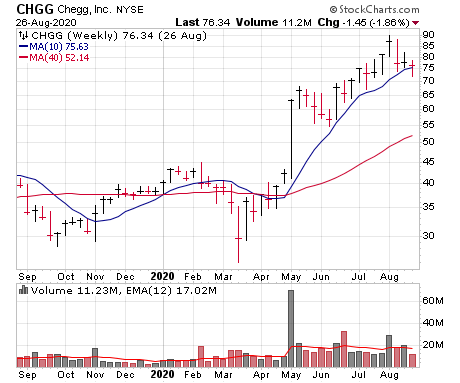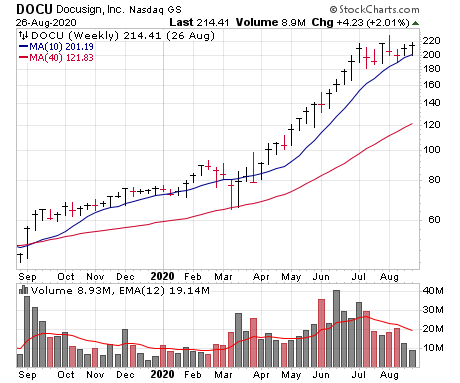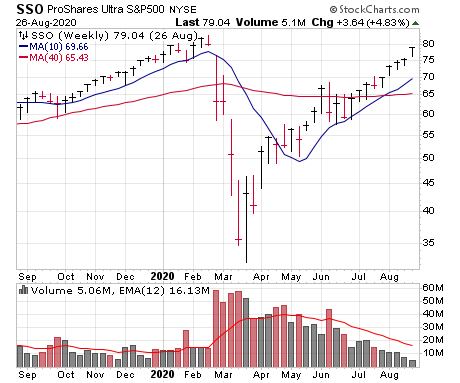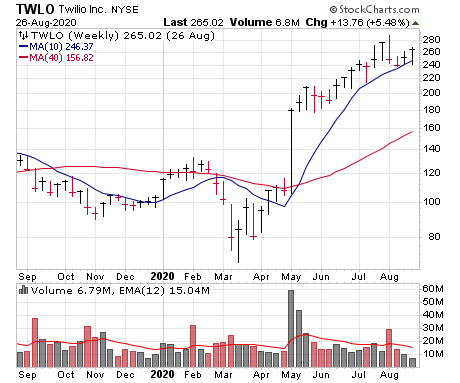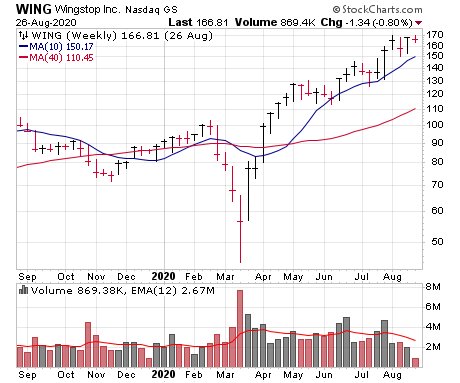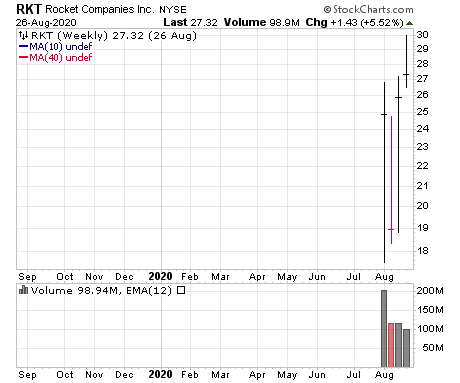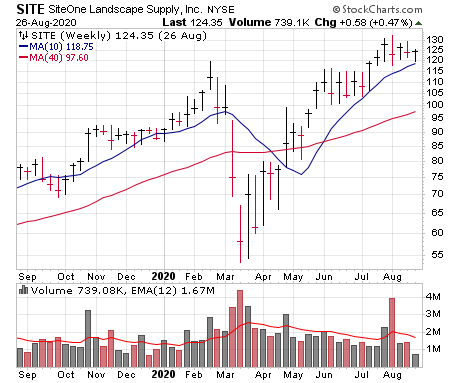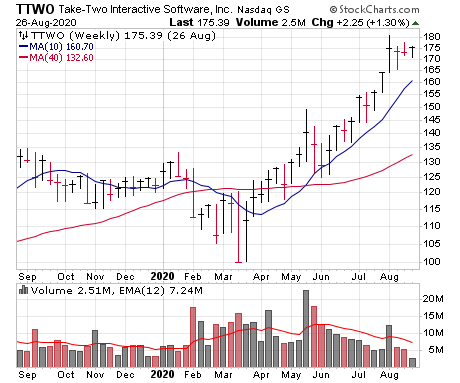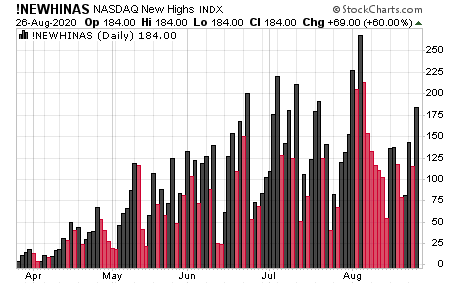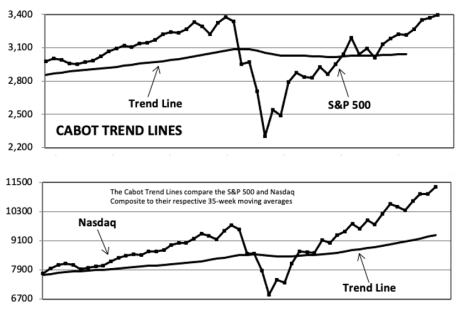Growth stocks remain mostly hit or miss, but the evidence has improved somewhat during the past couple of weeks. We’re not flooring the accelerator, but we are doing a little new buying tonight, though still keeping about one-quarter of the Model Portfolio in cash.
Elsewhere in tonight’s issue, we talk about the thinning out of the advance and dive into all our stocks (a couple of which have earnings coming up), as well as talk about our new recommendations and game plan going forward.
Cabot Growth Investor 1453
[premium_html_toc post_id="213087"]
Has the “Re-Rotation” Begun?
When our last issue went to press, growth stocks were under pressure. It wasn’t an epic disaster, but there had clearly been a change in character, with the initial market leaders (those that burst to new highs in April or early May) showing funky action while money rotated elsewhere. Some even broke intermediate-term support, and in response we booked some profits while holding core positions.
And frankly, we still think many names look suspect. Or maybe suspect isn’t the right word—as we wrote in the last issue, many of those initial leaders still look a bit tired, needing more rest after huge runs in the past few months. Add in the fact that the rally has narrowed (see our writeup later in this issue for that) and the big-cap indexes are a bit out of trend on the upside (which often leads to some wobbles) and we’re OK holding some cash here.
That’s the cautionary side of things. But it’s also fair to say the evidence has improved during the past two weeks. Growth stocks in general have perked up again (our Aggression Index tagged new highs this week as the Nasdaq has ramped), and more “fresh” leaders have begun to flex their muscles, with many reacting well to earnings and some pushing to new highs.
It’s too soon to say for sure, but it’s possible we’re starting to see a “re-rotation” back into growth stocks—or at least, the end of a sharp rotation out of growth titles. Plus, of course, the Cabot Trend Lines and Cabot Tides remain firmly positive, with lots of big-picture evidence telling us this bull market has farther to run.
So where does that leave us? The good doesn’t completely outweigh the bad, but the combination of us coming into the growth stocks’ weak spell with some cash and then us booking a series of profits has left us with 35% on the sideline. And that seems like too much given what we see right now.
So we’re putting a little of that back to work tonight, buying two new half-sized positions—if growth stocks fall apart again, we’ll take a minor lump or two, but we think there’s a chance some of these fresher names are starting new runs. And in case we’re wrong, we still have a quarter of the portfolio in cash for some cushion.
What To Do Now
Put a little money back to work. In the Model Portfolio, we’re going to buy half-sized positions (5% of the account) in both Roku (ROKU) and Spotify (SPOT), which will leave us with 25% on the sideline. Meanwhile, we’re practicing patience with our remaining winners, though a couple names have earnings reports to get through in the next few trading days (Okta is tonight) that could have an impact. Details below.
Model Portfolio Update
We’ve been relatively quiet on the buy side for many weeks, which isn’t really normal for us. But even so, the key isn’t how much you trade--we know many investors who are very active and do well, and others that sit for longer than us and do great. The most important thing is making the right decisions within a system that puts the odds in your favor. So far, we think we’ve done a good job of that this year, holding winners, trimming them more recently and easily outpacing the major indexes in 2020.
As for what comes next, we’re still not in a hurry to jump in with both feet, but we also are a bit more positive than we were in the last issue—growth stocks are still somewhat ragged, but many have held support and begun to perk up, while some fresher names are lifting. Thus, tonight, we’re taking half positions in both ROKU and SPOT, as we think both could be leaders of the next up-leg in growth stocks. After the buys, our cash position will be around 25%, which gives us both cushion and buying power going forward.
Current Recommendations
Stock | No. of Shares | Portfolio Weightings | Price Bought | Date Bought | Price on 8/27/20 | Profit | Rating |
Chegg (CHGG) | 1,601 | 7% | 69 | 5/22/20 | 75 | 9% | Hold |
Cloudflare (NET) | 3,616 | 7% | 26 | 4/20/20 | 40 | 52% | Hold |
Dexcom (DXCM) | 289 | 7% | 216 | 11/15/19 | 431 | 100% | Hold |
DocuSign (DOCU) | 655 | 7% | 65 | 9/13/19 | 215 | 231% | Hold |
Okta (OKTA) | 632 | 7% | 150 | 4/20/20 | 222 | 48% | Hold |
ProShares Ultra S&P 500 (SSO) | 2,612 | 11% | 60 | 5/29/20 | 80 | 33% | Buy |
Roku (ROKU) | New | — | — | — | 161 | — | Buy a Half |
Spotify (SPOT) | New | — | — | — | 274 | — | Buy a Half |
Twilio (TWLO) | 553 | 7% | 174 | 5/8/20 | 263 | 51% | Hold |
Wingstop (WING) | 1,313 | 12% | 128 | 6/19/20 | 167 | 30% | Buy |
CASH | $658,580 | 35% |
Chegg (CHGG 75)—Chegg has been one of our weaker performers during the multi-week growth stock slog; shares didn’t bounce much in the middle of the month and actually probed below their 50-day line before lifting a bit. Near-term, the stock looks like it still has some work to do, especially with its huge convertible share offering ($1 billion, which diluted the share count by a whopping 10%!). But having already taken partial profits, we’re not willing to give the stock the boot—the longer-term outlook has brightened significantly with online learning hitting the mainstream (analysts see earnings up 35% this year and 22% next, and the figures keep creeping up and are likely low), and chart-wise, the overall picture (from 55 after earnings to a high of 90 down to a low of 73) isn’t out of the ordinary. A drop into the upper 60s (maybe a point or two below our average cost of 69) would likely have us cutting bait, but CHGG is notoriously squirrelly, so we’re willing to give it a little rope. HOLD.
Cloudflare (NET 40)—The firestorm surrounding TikTok and U.S. regulators has damaged Cloudflare’s peer Fastly (TikTok accounts for 12% of Fastly’s revenues), which has put a bit of a damper on the entire content delivery and cloud networking area. Cloudflare is one of those, and that’s probably the big reason why NET hasn’t bounced nearly as well as most growth names in recent days. However, it’s hardly a disaster—so far, shares have held their 50-day line a couple of times, and there have been subtle bullish clues (not to get too far into the weeds, but the huge-volume down week earlier this month was actually support, as NET closed well on the week and held the 10-week line) that indicate the big-picture run is still intact. All in all, though, we think we’re in the right place—we took a nice partial profit earlier this month, and we think Hold remains the appropriate rating for now. HOLD.
Dexcom (DXCM 431)—DXCM continues its up-and-down action; it’s basically unchanged since early May. Is this a multi-month top? Or a new launching pad? We’re flexible, of course, but we continue to lean toward this period being the pause that refreshes, especially as selling volume has been light and the stock is now tightening up (many weekly closes in the 420 to 430 area during the past few weeks), which is usually a good thing. (We also think the gradual easing of stay-at-home orders should help business as more people return to/catch up on doctor’s appointments.) As usual, we’ll just play it by the book—a sharp breakdown into the 360 to 370 area would likely lead us to sell some or all of our position, but any high-volume lift from here could signal the start of the next advance. Today, with the stock’s trend sideways, we’ll just stand pat. HOLD.
DocuSign (DOCU 215)—The revival in cloud and software stocks last week and (especially) this Tuesday has aided DocuSign, which has again found support right near its 10-week line (currently around 201 and rising) and pushed to the middle of its recent range. Whether the stock needs time (and lower prices) to catch its breath or not will probably come down to earnings next Thursday (September 3) after the market close—analysts see revenues of $319 million (up 35% from a year ago) and earnings of eight cents per share (up from a penny last year), though any commentary on demand trends as the summer progressed (did a relaxation of stay-at-home orders lead to more in-person signings?) will be key. The fact that some software names popped this week tells us buyers are still lurking for the group, but we’ll just have to see how it goes. Stepping back, we still think higher prices are coming down the road, as you don’t have many companies with the story, numbers (earnings up 58% this year and 71% next) and chart of DOCU. But near-term, we’ll wait to play our cards until after seeing the stock’s reaction to earnings. HOLD.
Okta (OKTA 222)—OKTA was one of the first of the initial leading growth stocks (those that hit new highs in April or early May) to hit turbulence (back in early July), but it may be one of the first of that group to get going—shares ripped back toward their highs yesterday on heavy volume, making the past seven weeks look like a well-contained, tidy base. (To be fair, like many stocks that have rested, the relative performance line is still shy of its old peak by a bit, which would need fixing.) That said, the next big move will likely be determined tonight: Okta’s quarterly report is due out after the close, with revenues expected to come in just above $186 million (up 32% from last year) while the firm likely lost two cents per share, though as always, the outlook will be just as important. Given the multi-month “reset” base the stock went through and the initial strength right off the lows, we’re optimistic OKTA remains early-ish in a new advance; we’d like to go back to Buy, but we’ll see how shares react to earnings. HOLD.
ProShares Ultra S&P 500 Fund (SSO 80)—SSO gyrated in the month after our recommendation, but since tagging its 50-day line near the end of June, it’s been a smooth ride higher, with the buying accelerating in recent days. (So far, you can chalk up another win for the blastoff indicators that flashed in late May/early June.) While the S&P 500 has been a bit extended to the upside for a while, it’s now also getting out of trend on the upside; that’s fun if you own some, but just a heads up that such action often (not always) leads to some short-term indigestion. We’ll stay on Buy, as the trends are obviously strong and most signposts point to higher prices down the road, but short-term, it’s probably best to look for dips or keep new positions small. BUY.
Roku (ROKU 161)—Roku is one of the biggest beneficiaries of the cord-cutting movement, with a neutral platform (incorporated into its own hardware and many of the best-selling TVs on the market) that serves as a gateway for 43 million people (up 41% from a year ago) to access all of the streaming services out there. It’s the #1 streaming platform in the U.S. overall, mostly because it’s not competing with anyone (the more services there are, the better for Roku). Top-line growth has been great for a while, and as you’d expect, the pandemic boosted results (largest net increase in new accounts outside of a holiday quarter), with platform revenue up 46%, revenue per user up 18% and the number of hours streamed up a huge 65% (to a mind-boggling 14.6 billion hours); analysts see the top line growing 41% this year and another 34% next as cash flow improves. (To be fair, earnings are still in the red.) As for the stock, it has a history of wild rides (up and down), but it’s etched a year-long base, has had some tightness in recent weeks and is beginning to perk up—volatility will be extreme (don’t be shocked to see some potholes), but we’re going to add a half-sized position (5% of the Model Portfolio) here with a mental stop in the low 140s/high upper 130s. BUY A HALF.
Spotify (SPOT 274)—We’ve been spying Spotify for many weeks now, and with the stock rallying off its 50-day line, we’re going to step in with a half position (5% of the Model Portfolio). As we’ve written before, the firm reminds us a lot of Netflix a few years ago—no, Spotify has nothing to do with streaming video, but it’s the leader in a big field (streaming music) and has made some bold moves into what should the next big growth area (podcasts), signing up numerous big names and inking deals for original content podcasts, which should keep subscriber growth strong and give the firm far more leverage on (a) negotiating deals and (b) attracting other firms and podcast providers. The stock formed a huge post-IPO base, broke out in May and then showed abnormal strength in June, flashing “double skyscrapers” (two giant-volume weeks in a row) as it lifted above its all-time high. The two-month rest since then has been normal, with aforementioned support near the 50-day line. There are never any guarantees in the market, but SPOT has the type of setup that, if you took the trade 10 times, it should work seven or eight of those. We’ll start with a half-sized position and look to average up if it pushes higher. BUY A HALF.
Twilio (TWLO 263)—The first test of the 50-day line after a big breakout and strong run is usually a place big investors step in, and so far that’s been the case for TWLO, which has found support in the 240 range for a few weeks and popped nicely yesterday. The company has been quiet on the news front since a big ($1.25 billion) share offering earlier this month, though it will be added to the MSCI U.S. Large Cap Index (likely not a big deal for the stock). Fundamentally, there are some worries that revenue growth has decelerated over the past two quarters (from 86% in Q4 to 46% in Q2 and 40% expected in Q3), but we’re not reading too much into that—Twilio has emerging blue chip written all over it as companies of all sizes automate communications (text, email, video) and move to cloud-based call centers. We’ll stay on Hold here, but we’re looking to restore TWLO’s Buy rating should the recent pop gain steam. HOLD.
Wingstop (WING 167)—WING has returned to its post-earnings highs, albeit on very light volume; further hesitation wouldn’t shock us at all, but overall, the trend remains strongly up, and we expect higher prices ahead as the company is one of the poster boys for the rapid, reliable growth profile that big investors yearn for—Wingstop is working on its 17th straight year of domestic same-store sales growth (the slowest growth was 1.3% growth in 2010), has less than 1% closure rate of stores for the last five years, recoups the investment of a new store in less than two years and new store performance has been consistent every year, with industry-leading margins. Translation: Wingstop is a very good and well-managed company with a very bright future. We’re fine buying some here or (preferably) on dips. BUY.
Watch List
- DraftKings (DKNG 39): DKNG can be all over the place, but Q2 results were fine, the long-term future is bright and the stock’s 13-week launching pad looks good.
- Pinterest (PINS 35): PINS has rested for about a month since its huge earnings gap. We like the story and think the next major move is up.
- Zillow (Z 86): There are many attractive housing investments (including Rocket; see below), but Zillow is the most straightforward way to play the new housing boom, and the stock’s uptrend looks great.
Other Stocks of Interest
The stocks below may not be followed in Cabot Growth Investor on a regular basis. They’re intended to present you with ideas for additional investment beyond the Model Portfolio. For our current ratings on these stocks, see Updates on Other Stocks of Interest on the subscriber website or email mike@cabotwealth.com.
Rocket Companies (RKT 27)—We’ve written a bunch about the new housing boom that looks to be underway; we won’t rehash all of that, but suffice it to say that all the recent numbers (existing home sales hit their highest level since 2007 in July!) are pointing in the right direction. Rocket Companies is a recently-public outfit that has its roots back to the mid 1980s, but for investors, history really started in 2015, when the firm (via its Rocket Mortgage subsidiary) revolutionized the mortgage industry by launching its end-to-end digital online platform—its best-in-class automation boosts productivity (closed an average of 8.3 loans per month per sales member; industry average is 2.3), while a focus on customer service has won it annual awards every decade. Throw in a lot of marketing (digital-first brand) and the results have been amazing—Rocket is now the largest mortgage originator in the U.S. (9.2% of the market in Q1 2020), though the industry remains very fragmented (the top five players account for just 17%-ish of the market), leaving plenty of room for growth as originations move online. Rocket has also branched out into mortgage servicing, auto and personal lending, and it’s starting to move into overseas markets, too. Growth has been fantastic, with revenues up 116% in Q1, while preliminary Q2 results show revenue up a ridiculous 469% from a year ago! (The full report is due out next Wednesday, September 2) That pace can’t continue forever, of course, and was likely boosted by the pandemic pushing everything online, but there’s little doubt that should the housing market pick up steam, so will Rocket’s bottom line, which is already solidly profitable. The stock is very volatile and hot (like many recent IPOs), but it trades a ton of volume (north of $500 million per day!) and leapt to new highs earlier this week. If you buy, keep it small, especially with earnings coming up.
SiteOne Landscape (SITE 126)—SiteOne Landscape has always been one of our favorite stories—it’s the largest (more than four times the size of its closest competitor) and only national wholesale distributor of landscape supplies, which is a huge ($20 billion), slow-growing market. So where does the growth come from? Acquisitions! The industry remains highly fragmented, and SiteOne is busy consolidating it, buying out select local operations all over the U.S.; it bought 13 firms in 2018, 10 more last year and has completed four this year despite the pandemic, bringing onboard a total of $373 million of annual revenue and 108 branches. Despite the growth and buyouts, the firm has just 12% of the total market, so as long as it has access to capital, there’s no reason SiteOne won’t get a lot bigger over time. Beyond the buyouts, business is catching an uplift like many cyclical names after a rough April; sales actually increased 9% in Q2 (even excluding acquisitions they were up 3%), while EBITDA ramped up 16%, and in its second quarter report, management said demand picked up in May and June, with July continuing to accelerate. Thus, following a pothole, things are back on track, and SiteOne is also restarting acquisition activities (a recent share offering should help that cause). As for the stock, it rested just south of all-time highs in May, moved to virgin turf in July and has pulled back to its 10-week line in August (after the aforementioned share offering). The only trick here is liquidity—shares are relatively thinly traded (350,000 shares per day), which is something to consider, but chart-wise, SITE appears to be near a solid risk-reward entry level.
Take-Two Interactive (TTWO 174)—Take-Two is one of the leading video game stocks, riding success in major hits (like Grand Theft Auto). We admit we’ve never been huge fans of the video game stocks, mostly because they’ve historically been a bit like movie studios—hit games would give earnings a one-time boost, meaning they lack the rapid, reliable growth that often causes big investors to pile in. But in recent years the focus has shifted to more steady forms of income (including micro-transactions, where people pay in-game for better tools, weapons or additional content), and that’s a big focus for Take-Two; in Q2, net bookings boomed 136% and so-called recurring consumer spending (such as the items listed above) made up 65% of the total, providing a little reliability in terms of cash flow. More important, management hiked estimates for the rest of the year thanks both to the great Q2 numbers and the slate of solid game releases scheduled. (PGA Tour 2K21 just came out last week, with another four going live before year-end.) There will still be some lumpiness in the numbers, but the bottom line is that business is good, and analysts see earnings up 35% this year and another 17% next. Even better than that is the stock, which began a long consolidation phase in 2017 and finally broke free from that in early July; after an accelerated upmove before and after earnings, TTWO has settled down nicely during the past three weeks. Shares look poised to do well down the road.
Thinning Out: Descriptive, but Not Always Predictive
While there’s been talk of a narrow market advance for months, the fact is that as the indexes moved higher all year, so did the number of stocks hitting new 52-week highs—not nearly as elevated as what we saw back in February, but the best way to measure it is from a major low (in March), and with that in mind, all looked “in gear” for most of the post-crash rally.
But now that’s starting to change, which is a sure sign that the rally has thinned out. Shown here are charts of the Nasdaq (on top) and of the number of stocks on that exchange hitting new highs (on bottom). From next to nothing at the March low, the number of stocks getting out to virgin turf continued to increase as the Nasdaq marched higher. When things were hot in early August, a maximum of 267 stocks hit new highs (on the fifth of the month)! But as the indexes have pushed even higher, fewer stocks are doing the same, with a max of 184 yesterday.
So is that bearish? Well, yes and no. It’s true that a thinning advance is usually seen before market corrections, and this five-month upmove could certainly decide to take a breather. But there are exceptions that pop up all over the place. For example, the Nasdaq/new high dynamic after the 2016 election and into the 2017 bull market saw new highs peak in December of 2016, but that didn’t stop the market from having a huge run during the following year.
In our view, it’s better to use secondary evidence like new highs (as well as stuff like sentiment) as more descriptive than predictive. There’s no doubt that the current environment has become more selective; said another way, it’s become harder to make money, which argues for a somewhat more cautious stance—depending on what stocks you own. That said, you shouldn’t use these figures to look too far ahead; a “real” correction is certainly possible, but there’s a chance money re-rotates into growth areas without a major dip.
When Should you Re-Enter a Stock?
Selling is always tricky (only liars buy at the bottom and sell at the top), so it’s inevitable that there will be times when you pull the plug on a holding only to see the stock rebound quickly, making you wonder whether you just messed up the trade. And, really, at no time is the buying urge greater than in this situation; anytime we sell something, especially if it’s been a winner for us, any strong bounce back has many readers wanting to jump back in.
The example recently was Teladoc (TDOC), which we made great money on, but sold after the stock suffered abnormal weakness (massive-volume selling below the 50-day line) after its purchase of Livongo. And shares did continue lower after that by another few percent—before turning around and recouping more than half of its overall decline in just a few days! (It’s since sagged back a bit.) That led to a barrage of questions of whether we sold out incorrectly—and whether to buy back in.
For Teladoc’s case, our answer is still: We don’t think it’s a great buy here, as the big run in the stock combined with the monster-volume decline has likely put in a top for a while. As for the general question—once you sell a stock, you should compare it to all other stocks you don’t own. If it’s really the best looking one (with the best story, numbers, etc.), then yes, hop back in.
What you want to avoid are biased buys, where you’re jumping on because a stock has rebounded somewhat (which isn’t unusual) and it was good to you before. If you can’t help the emotion of jumping back on, put the following rule in place: If you sold 100 shares of XYZ stock and it’s rebounded, tell yourself that you have to buy more shares (say 110 to 120) if you buy it back. That will increase the hurdle and force you to think of whether you really want back in.
Long story short, there’s nothing wrong with getting back into a stock, but we prefer to let a stock set up again—and to make sure it’s the best of the best of what’s available.
Cabot Market Timing Indicators
The top-down evidence for the market remains bullish, with the trends super strong (maybe a bit too strong, short-term), and we’re pleased to see some growth stocks perk up again (including some fresher names). Thus, we’re doing a little buying tonight, but we’re not flooring the accelerator, instead taking things on a stock-by-stock basis.
Cabot Trend Lines: Bullish
Our Cabot Trend Lines remain in the stratosphere, as the huge recovery as pushed both major indexes well above their respective trend line. At the end of last week, the S&P 500 stood 10.9% above its 35-week line, while the Nasdaq was a huge 21.1% above its own moving average. As we’ve been saying of late, such extreme readings usually lead to a retreat, but the odds strongly favor higher prices in the months ahead.
Cabot Tides: Bullish
Our Cabot Tides are also still bullish, with all five indexes we track (including the S&P 500, daily chart shown here) nicely above their lower (50-day) moving average. On the downside, some of the broader indexes (small and mid caps, etc.) have begun to stagnate again, so a 3% to 4% drop could get put the Tides on the fence. But there’s no question the intermediate-term trend is clearly up today.
Cabot Real Money Index: Neutral
The outflow of money from equity funds and ETFs has been slowing somewhat during the past few weeks, with the five-week sum of flows creeping higher. Even so, our Real Money Index remains in neutral territory as investors aren’t making any huge, market-telling moves into our out of the market of late.
Charts courtesy of StockCharts.com
The next Cabot Growth Investor issue will be published on September 10, 2020.
Cabot Wealth Network
Publishing independent investment advice since 1970.
CEO & Chief Investment Strategist: Timothy Lutts
President & Publisher: Ed Coburn
176 North Street, PO Box 2049, Salem, MA 01970 USA
800-326-8826 | support@cabotwealth.com | CabotWealth.com
Copyright © 2020. All rights reserved. Copying or electronic transmission of this information is a violation of copyright law. For the protection of our subscribers, copyright violations will result in immediate termination of all subscriptions without refund. No Conflicts: Cabot Wealth Network exists to serve you, our readers. We derive 100% of our revenue, or close to it, from selling subscriptions to its publications. Neither Cabot Wealth Network nor our employees are compensated in any way by the companies whose stocks we recommend or providers of associated financial services. Disclaimer: Sources of information are believed to be reliable but they are not guaranteed to be complete or error-free. Recommendations, opinions or suggestions are given with the understanding that subscribers acting on information assume all risks involved. Buy/Sell Recommendations: All recommendations are made in regular issues or email alerts or updates and posted on the private subscriber web page. Performance: The performance of this portfolio is determined using the midpoint of the high and low on the day following the recommendation. Cabot’s policy is to sell any stock that shows a loss of 20% in a bull market or 15% in a bear market from the original purchase price, calculated using the current closing price. Subscribers should apply loss limits based on their own personal purchase prices.

